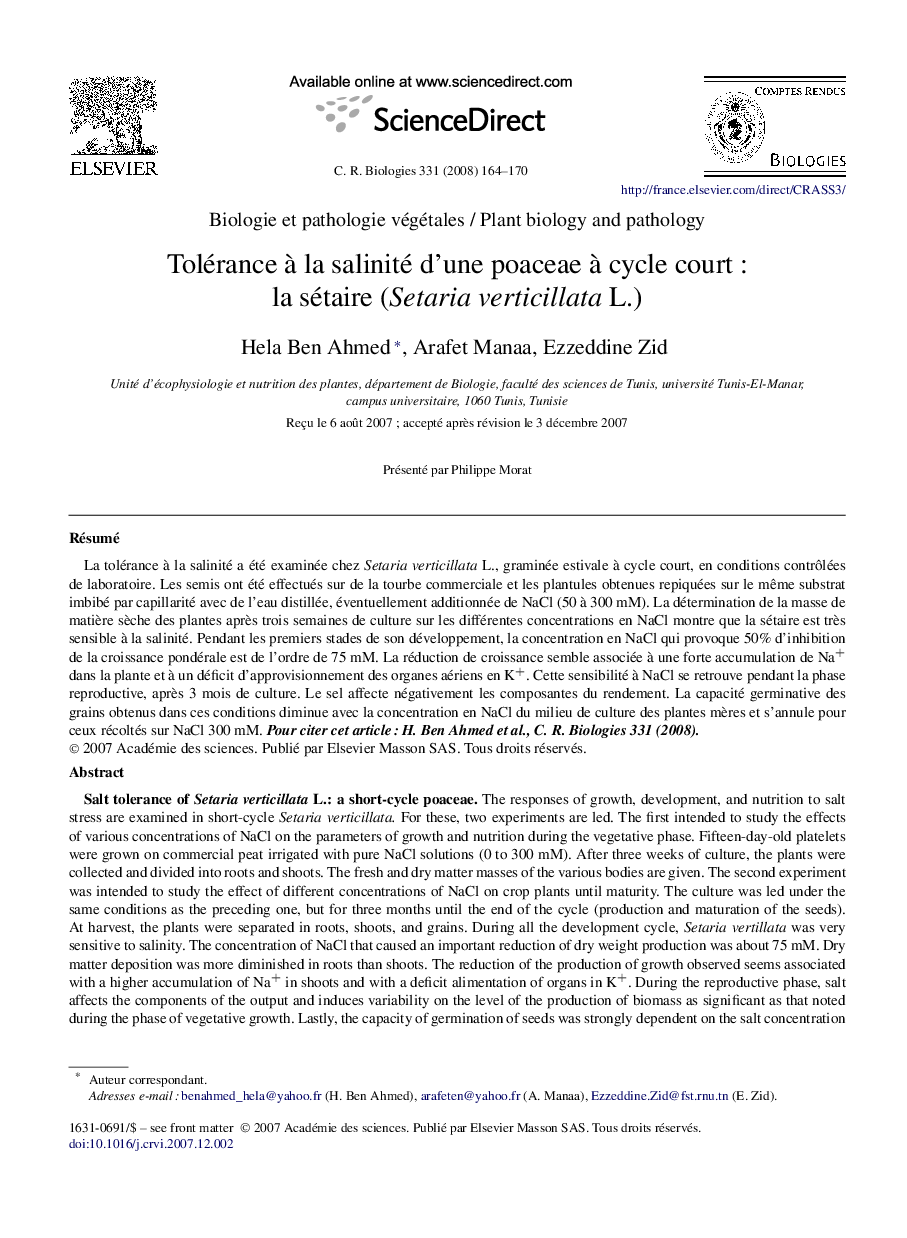| Article ID | Journal | Published Year | Pages | File Type |
|---|---|---|---|---|
| 2784208 | Comptes Rendus Biologies | 2008 | 7 Pages |
RésuméLa tolérance à la salinité a été examinée chez Setaria verticillata L., graminée estivale à cycle court, en conditions contrôlées de laboratoire. Les semis ont été effectués sur de la tourbe commerciale et les plantules obtenues repiquées sur le même substrat imbibé par capillarité avec de l'eau distillée, éventuellement additionnée de NaCl (50 à 300 mM). La détermination de la masse de matière sèche des plantes après trois semaines de culture sur les différentes concentrations en NaCl montre que la sétaire est très sensible à la salinité. Pendant les premiers stades de son développement, la concentration en NaCl qui provoque 50% d'inhibition de la croissance pondérale est de l'ordre de 75 mM. La réduction de croissance semble associée à une forte accumulation de Na+ dans la plante et à un déficit d'approvisionnement des organes aériens en K+. Cette sensibilité à NaCl se retrouve pendant la phase reproductive, après 3 mois de culture. Le sel affecte négativement les composantes du rendement. La capacité germinative des grains obtenus dans ces conditions diminue avec la concentration en NaCl du milieu de culture des plantes mères et s'annule pour ceux récoltés sur NaCl 300 mM. Pour citer cet article : H. Ben Ahmed et al., C. R. Biologies 331 (2008).
The responses of growth, development, and nutrition to salt stress are examined in short-cycle Setaria verticillata. For these, two experiments are led. The first intended to study the effects of various concentrations of NaCl on the parameters of growth and nutrition during the vegetative phase. Fifteen-day-old platelets were grown on commercial peat irrigated with pure NaCl solutions (0 to 300 mM). After three weeks of culture, the plants were collected and divided into roots and shoots. The fresh and dry matter masses of the various bodies are given. The second experiment was intended to study the effect of different concentrations of NaCl on crop plants until maturity. The culture was led under the same conditions as the preceding one, but for three months until the end of the cycle (production and maturation of the seeds). At harvest, the plants were separated in roots, shoots, and grains. During all the development cycle, Setaria vertillata was very sensitive to salinity. The concentration of NaCl that caused an important reduction of dry weight production was about 75 mM. Dry matter deposition was more diminished in roots than shoots. The reduction of the production of growth observed seems associated with a higher accumulation of Na+ in shoots and with a deficit alimentation of organs in K+. During the reproductive phase, salt affects the components of the output and induces variability on the level of the production of biomass as significant as that noted during the phase of vegetative growth. Lastly, the capacity of germination of seeds was strongly dependent on the salt concentration of the culture medium of the plants mothers, a total loss of viability appearing on crop plants collected in the presence of NaCl 300 mM. To cite this article: H. Ben Ahmed et al., C. R. Biologies 331 (2008).
